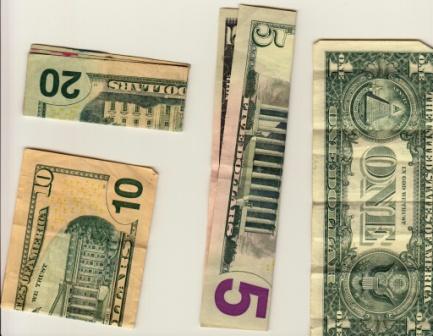When I started collecting, I have collected bank notes, among many other things. The better question was, what didn’t I collect? It is a very interesting subject that I still follow today, but I stopped collecting notes.
In many countries blind people can recognize paper currencies. Some countries have braille marks on the notes, others have tactile marks, currencies like the Euro come in different sizes, and in other countries, like in the US, it is impossible to recognize notes by touch.
In the European Union people use a measuring stick with markings for the different coins, so when you lay the note on the stick, you can read the braille number from the stick that corresponds to the note. However, another common method is just using your finger as the measuring stick. After a while you can get a feel for how wide the different notes are when you align the edge of it to your finger. Also, you can fold pieces of papers exactly the width of a note and label it with braille. Options are endless, and it is a personal preference. For people who have some remaining vision, the Euros are relatively easy to identify.
Theoretically it is a good thing to have tactile marks on the notes, but once the note becomes worn, it is harder to find. I remember the first Hungarian 5000 Forint had the braille number 5000 on it, but it wasn’t easy to feel. I heard that first the number was embossed on the note then it was painted which made it more difficult to feel. After a couple of years the notes were pretty hard to recognize.
In the US, it has been a long debate if notes should have braille, or any kind of markings, because all the notes are the same size. Currently the Bureau of Engraving and Printing is testing possibilities, but nothing entered circulation so far. With advanced technologies, there are apps on my phone which can help. I just hold a bank note to the camera and the app will tell me what it is. My favorite app, LookTell, knows the currencies of many countries. I even helped them to translate it to Hungarian, but that’s a very unrelated story. So, once I know what a note is, I fold it differently. I Don’t fold the one dollar bill, I fold the five lengthwise, fold the ten in half, and the twenty in half twice., once widthwise, once lengthwise. I fold the fifty in halves twice widthwise, and do not fold the hundreds, but keep them separately. For the most part, however, I do not carry anything larger than a twenty, just to make life easier.
On this picture you can see a sample of my wallet.
2019 update: I wrote a more dtailed post about how blind epople can identify paper money, and a related post about braille on money.
But back to collecting. I have about 50 different Hungarian notes, and almost a hundred from other countries that I either got from others or saved when I was traveling. In particular, I keep notes which have some identification for blind people, but when I got more serious about coin collecting, I have decided not to collect notes. It is just not something that interests me. After a while, they feel relatively identical, and are very hard to tell the difference when I have many together. With the coins, I can at least tell the difference if I work on trying to come up with ways to identify them. This is not to say that notes are that similar, the big difference is in the numbers. I could learn to identify tens or hundreds of notes, but certainly not thousands. Especially if the note is crisp, identification can be much easier, besides the size and material, you can feel much of the patterns and markings. The truth is, I am just not that interested, so I thought there was no point to continue collecting notes. I kept the more interesting ones, and will never get rid of the Hungarian ones, I got many of them from my grandfather who has since passed away, so I will most likely give these to my kids one day. Not soon though…
Update from 2019:
I am still not really collecting banknotes, but I started to acquire a few tactile currencies to understand how different countries deal with money recognition. The ideas are diverse, some are better than others, which probably will be worth another post.
I also wrote a post recently about the challenges of collecting paper currency which goes into a greater detail about the above topic.



Hi Tom,
that’s an ingenious system. I suppose you start or end your day identifying your bills and then fold them accordingly. Is that common amongst blind people to do it like that? Or does everybody have their own small “tricks” to make life easier?
If yes, you should try to tell us about that as well?
Regards
Ole
Hi Ole,
As much as I know, this is the most frequently used “trick”, it works pretty well, and isn’t time consuming. Just have to make sure that you identify each note when you receive it, either by using the phone, or asking somebody. Then you fold it, put it away, and keep it that way until you spend it. Even though the phone makes it easy to recognize notes, it takes longer than just recognizing folded currency, and it can hold up the line at the counter, so I’m still using the folding system. There isn’t a set way of folding notes though, the system I described works for me. I learned it at the school for the blind when I first came to the US, and there was no reason to change it.